2001 CHRYSLER VOYAGER relay
[x] Cancel search: relayPage 1377 of 4284
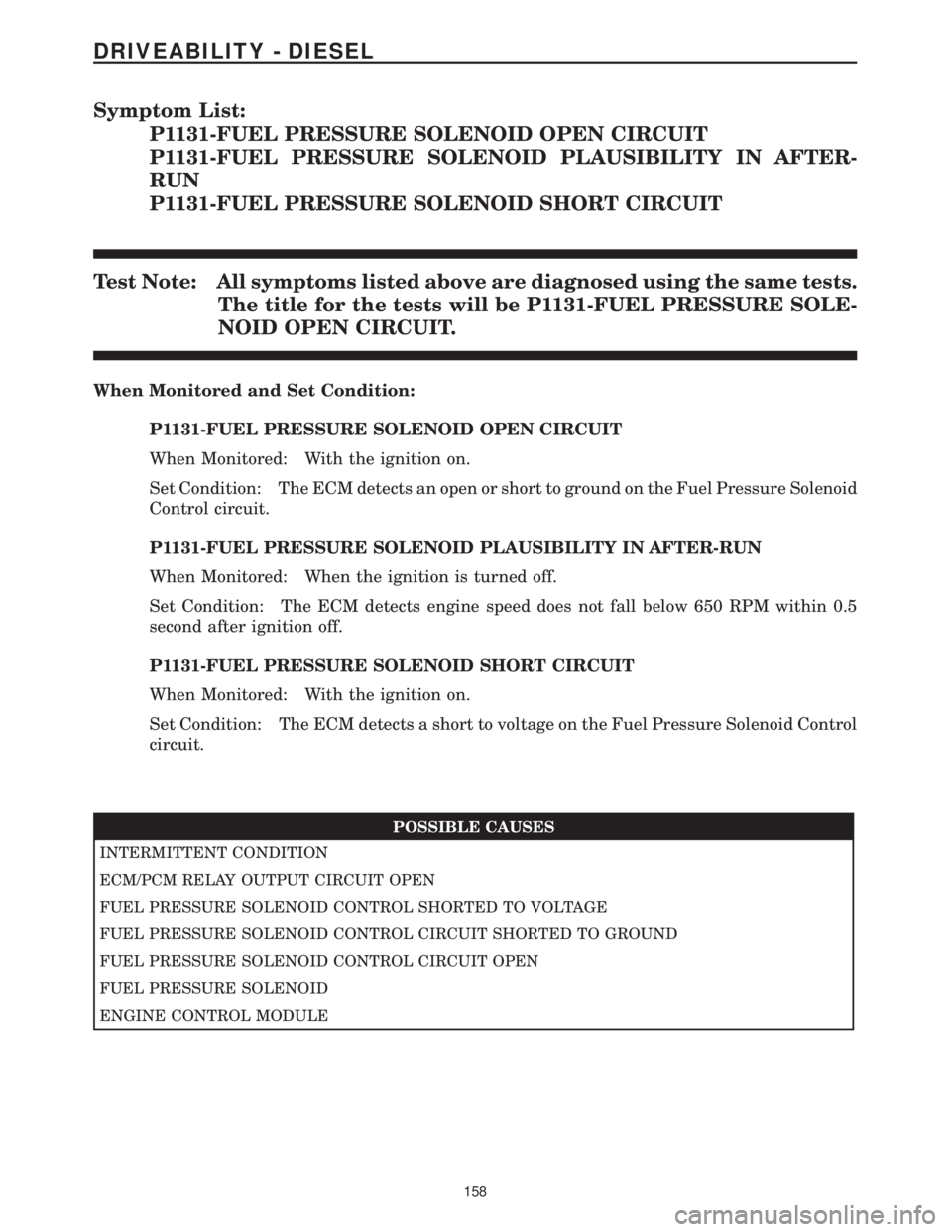
Symptom List:
P1131-FUEL PRESSURE SOLENOID OPEN CIRCUIT
P1131-FUEL PRESSURE SOLENOID PLAUSIBILITY IN AFTER-
RUN
P1131-FUEL PRESSURE SOLENOID SHORT CIRCUIT
Test Note: All symptoms listed above are diagnosed using the same tests.
The title for the tests will be P1131-FUEL PRESSURE SOLE-
NOID OPEN CIRCUIT.
When Monitored and Set Condition:
P1131-FUEL PRESSURE SOLENOID OPEN CIRCUIT
When Monitored: With the ignition on.
Set Condition: The ECM detects an open or short to ground on the Fuel Pressure Solenoid
Control circuit.
P1131-FUEL PRESSURE SOLENOID PLAUSIBILITY IN AFTER-RUN
When Monitored: When the ignition is turned off.
Set Condition: The ECM detects engine speed does not fall below 650 RPM within 0.5
second after ignition off.
P1131-FUEL PRESSURE SOLENOID SHORT CIRCUIT
When Monitored: With the ignition on.
Set Condition: The ECM detects a short to voltage on the Fuel Pressure Solenoid Control
circuit.
POSSIBLE CAUSES
INTERMITTENT CONDITION
ECM/PCM RELAY OUTPUT CIRCUIT OPEN
FUEL PRESSURE SOLENOID CONTROL SHORTED TO VOLTAGE
FUEL PRESSURE SOLENOID CONTROL CIRCUIT SHORTED TO GROUND
FUEL PRESSURE SOLENOID CONTROL CIRCUIT OPEN
FUEL PRESSURE SOLENOID
ENGINE CONTROL MODULE
158
DRIVEABILITY - DIESEL
Page 1378 of 4284
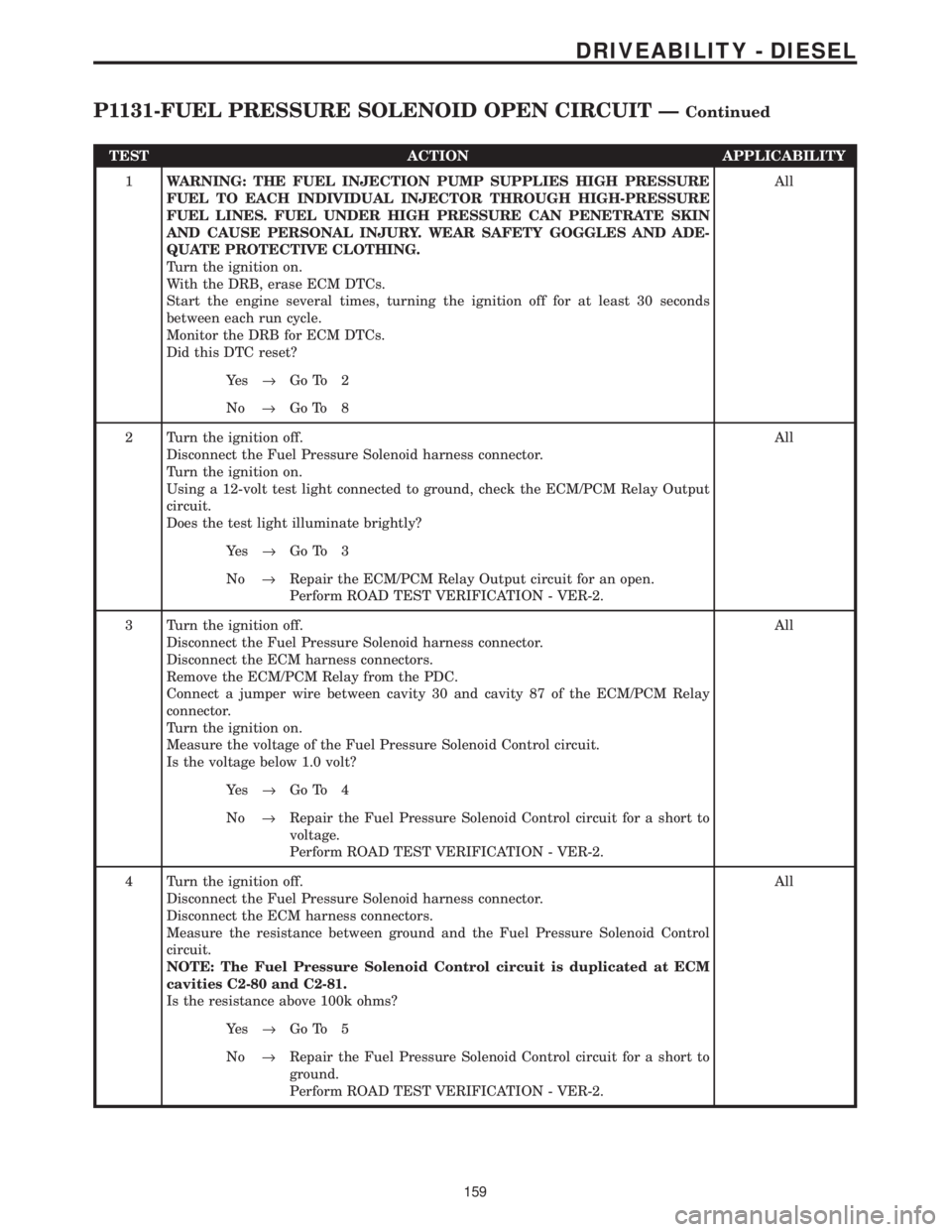
TEST ACTION APPLICABILITY
1WARNING: THE FUEL INJECTION PUMP SUPPLIES HIGH PRESSURE
FUEL TO EACH INDIVIDUAL INJECTOR THROUGH HIGH-PRESSURE
FUEL LINES. FUEL UNDER HIGH PRESSURE CAN PENETRATE SKIN
AND CAUSE PERSONAL INJURY. WEAR SAFETY GOGGLES AND ADE-
QUATE PROTECTIVE CLOTHING.
Turn the ignition on.
With the DRB, erase ECM DTCs.
Start the engine several times, turning the ignition off for at least 30 seconds
between each run cycle.
Monitor the DRB for ECM DTCs.
Did this DTC reset?All
Ye s®Go To 2
No®Go To 8
2 Turn the ignition off.
Disconnect the Fuel Pressure Solenoid harness connector.
Turn the ignition on.
Using a 12-volt test light connected to ground, check the ECM/PCM Relay Output
circuit.
Does the test light illuminate brightly?All
Ye s®Go To 3
No®Repair the ECM/PCM Relay Output circuit for an open.
Perform ROAD TEST VERIFICATION - VER-2.
3 Turn the ignition off.
Disconnect the Fuel Pressure Solenoid harness connector.
Disconnect the ECM harness connectors.
Remove the ECM/PCM Relay from the PDC.
Connect a jumper wire between cavity 30 and cavity 87 of the ECM/PCM Relay
connector.
Turn the ignition on.
Measure the voltage of the Fuel Pressure Solenoid Control circuit.
Is the voltage below 1.0 volt?All
Ye s®Go To 4
No®Repair the Fuel Pressure Solenoid Control circuit for a short to
voltage.
Perform ROAD TEST VERIFICATION - VER-2.
4 Turn the ignition off.
Disconnect the Fuel Pressure Solenoid harness connector.
Disconnect the ECM harness connectors.
Measure the resistance between ground and the Fuel Pressure Solenoid Control
circuit.
NOTE: The Fuel Pressure Solenoid Control circuit is duplicated at ECM
cavities C2-80 and C2-81.
Is the resistance above 100k ohms?All
Ye s®Go To 5
No®Repair the Fuel Pressure Solenoid Control circuit for a short to
ground.
Perform ROAD TEST VERIFICATION - VER-2.
159
DRIVEABILITY - DIESEL
P1131-FUEL PRESSURE SOLENOID OPEN CIRCUIT ÐContinued
Page 1381 of 4284
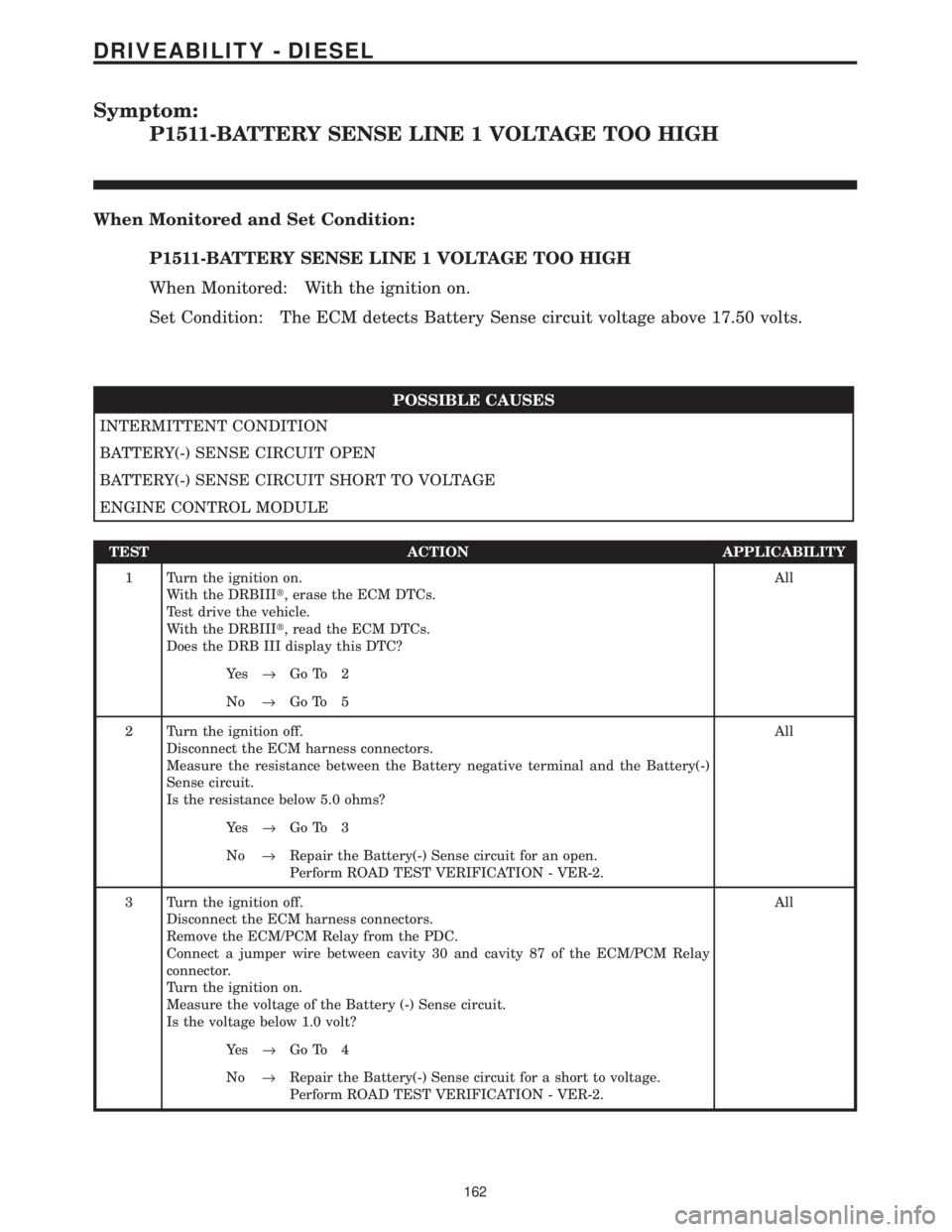
Symptom:
P1511-BATTERY SENSE LINE 1 VOLTAGE TOO HIGH
When Monitored and Set Condition:
P1511-BATTERY SENSE LINE 1 VOLTAGE TOO HIGH
When Monitored: With the ignition on.
Set Condition: The ECM detects Battery Sense circuit voltage above 17.50 volts.
POSSIBLE CAUSES
INTERMITTENT CONDITION
BATTERY(-) SENSE CIRCUIT OPEN
BATTERY(-) SENSE CIRCUIT SHORT TO VOLTAGE
ENGINE CONTROL MODULE
TEST ACTION APPLICABILITY
1 Turn the ignition on.
With the DRBIIIt, erase the ECM DTCs.
Test drive the vehicle.
With the DRBIIIt, read the ECM DTCs.
Does the DRB III display this DTC?All
Ye s®Go To 2
No®Go To 5
2 Turn the ignition off.
Disconnect the ECM harness connectors.
Measure the resistance between the Battery negative terminal and the Battery(-)
Sense circuit.
Is the resistance below 5.0 ohms?All
Ye s®Go To 3
No®Repair the Battery(-) Sense circuit for an open.
Perform ROAD TEST VERIFICATION - VER-2.
3 Turn the ignition off.
Disconnect the ECM harness connectors.
Remove the ECM/PCM Relay from the PDC.
Connect a jumper wire between cavity 30 and cavity 87 of the ECM/PCM Relay
connector.
Turn the ignition on.
Measure the voltage of the Battery (-) Sense circuit.
Is the voltage below 1.0 volt?All
Ye s®Go To 4
No®Repair the Battery(-) Sense circuit for a short to voltage.
Perform ROAD TEST VERIFICATION - VER-2.
162
DRIVEABILITY - DIESEL
Page 1383 of 4284
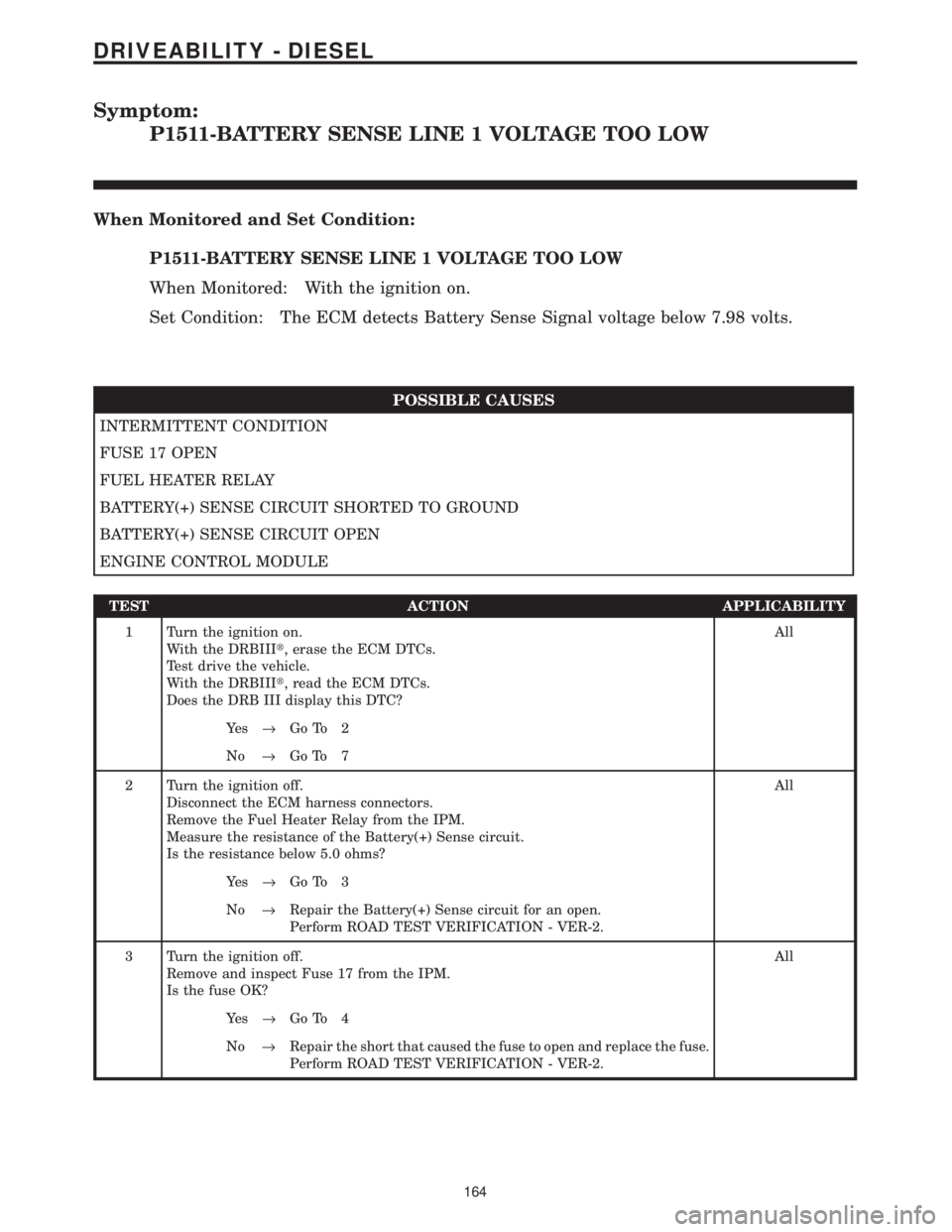
Symptom:
P1511-BATTERY SENSE LINE 1 VOLTAGE TOO LOW
When Monitored and Set Condition:
P1511-BATTERY SENSE LINE 1 VOLTAGE TOO LOW
When Monitored: With the ignition on.
Set Condition: The ECM detects Battery Sense Signal voltage below 7.98 volts.
POSSIBLE CAUSES
INTERMITTENT CONDITION
FUSE 17 OPEN
FUEL HEATER RELAY
BATTERY(+) SENSE CIRCUIT SHORTED TO GROUND
BATTERY(+) SENSE CIRCUIT OPEN
ENGINE CONTROL MODULE
TEST ACTION APPLICABILITY
1 Turn the ignition on.
With the DRBIIIt, erase the ECM DTCs.
Test drive the vehicle.
With the DRBIIIt, read the ECM DTCs.
Does the DRB III display this DTC?All
Ye s®Go To 2
No®Go To 7
2 Turn the ignition off.
Disconnect the ECM harness connectors.
Remove the Fuel Heater Relay from the IPM.
Measure the resistance of the Battery(+) Sense circuit.
Is the resistance below 5.0 ohms?All
Ye s®Go To 3
No®Repair the Battery(+) Sense circuit for an open.
Perform ROAD TEST VERIFICATION - VER-2.
3 Turn the ignition off.
Remove and inspect Fuse 17 from the IPM.
Is the fuse OK?All
Ye s®Go To 4
No®Repair the short that caused the fuse to open and replace the fuse.
Perform ROAD TEST VERIFICATION - VER-2.
164
DRIVEABILITY - DIESEL
Page 1384 of 4284
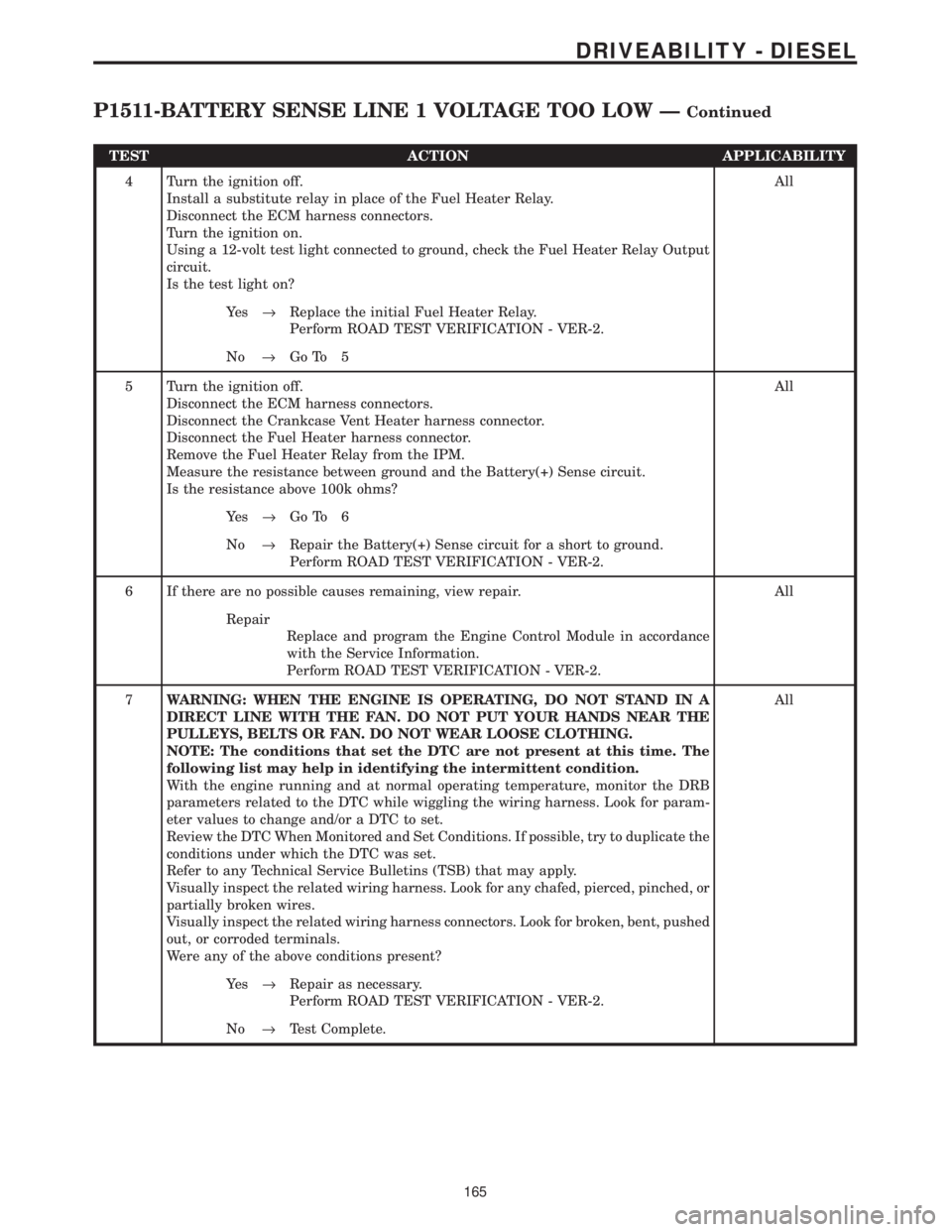
TEST ACTION APPLICABILITY
4 Turn the ignition off.
Install a substitute relay in place of the Fuel Heater Relay.
Disconnect the ECM harness connectors.
Turn the ignition on.
Using a 12-volt test light connected to ground, check the Fuel Heater Relay Output
circuit.
Is the test light on?All
Ye s®Replace the initial Fuel Heater Relay.
Perform ROAD TEST VERIFICATION - VER-2.
No®Go To 5
5 Turn the ignition off.
Disconnect the ECM harness connectors.
Disconnect the Crankcase Vent Heater harness connector.
Disconnect the Fuel Heater harness connector.
Remove the Fuel Heater Relay from the IPM.
Measure the resistance between ground and the Battery(+) Sense circuit.
Is the resistance above 100k ohms?All
Ye s®Go To 6
No®Repair the Battery(+) Sense circuit for a short to ground.
Perform ROAD TEST VERIFICATION - VER-2.
6 If there are no possible causes remaining, view repair. All
Repair
Replace and program the Engine Control Module in accordance
with the Service Information.
Perform ROAD TEST VERIFICATION - VER-2.
7WARNING: WHEN THE ENGINE IS OPERATING, DO NOT STAND IN A
DIRECT LINE WITH THE FAN. DO NOT PUT YOUR HANDS NEAR THE
PULLEYS, BELTS OR FAN. DO NOT WEAR LOOSE CLOTHING.
NOTE: The conditions that set the DTC are not present at this time. The
following list may help in identifying the intermittent condition.
With the engine running and at normal operating temperature, monitor the DRB
parameters related to the DTC while wiggling the wiring harness. Look for param-
eter values to change and/or a DTC to set.
Review the DTC When Monitored and Set Conditions. If possible, try to duplicate the
conditions under which the DTC was set.
Refer to any Technical Service Bulletins (TSB) that may apply.
Visually inspect the related wiring harness. Look for any chafed, pierced, pinched, or
partially broken wires.
Visually inspect the related wiring harness connectors. Look for broken, bent, pushed
out, or corroded terminals.
Were any of the above conditions present?All
Ye s®Repair as necessary.
Perform ROAD TEST VERIFICATION - VER-2.
No®Test Complete.
165
DRIVEABILITY - DIESEL
P1511-BATTERY SENSE LINE 1 VOLTAGE TOO LOW ÐContinued
Page 1385 of 4284
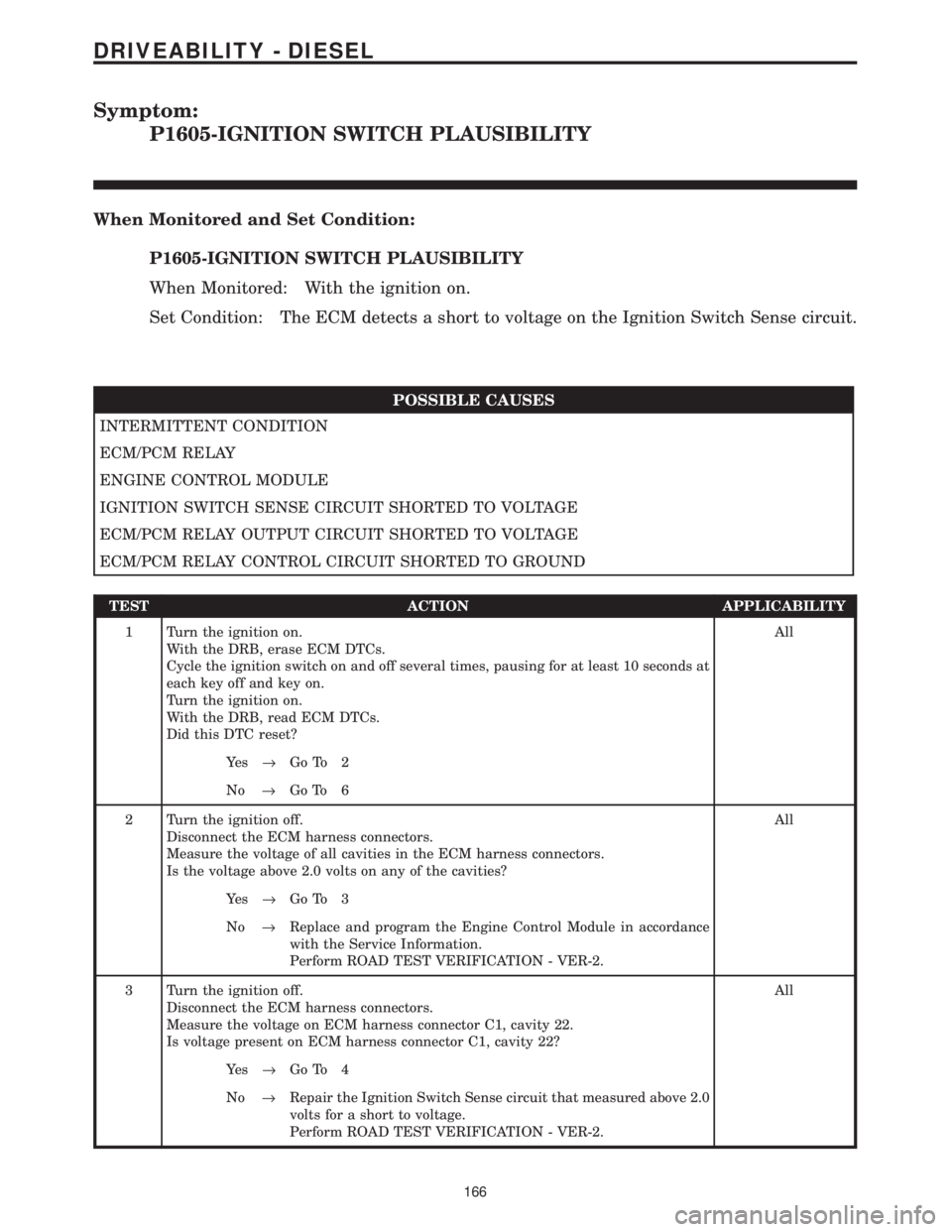
Symptom:
P1605-IGNITION SWITCH PLAUSIBILITY
When Monitored and Set Condition:
P1605-IGNITION SWITCH PLAUSIBILITY
When Monitored: With the ignition on.
Set Condition: The ECM detects a short to voltage on the Ignition Switch Sense circuit.
POSSIBLE CAUSES
INTERMITTENT CONDITION
ECM/PCM RELAY
ENGINE CONTROL MODULE
IGNITION SWITCH SENSE CIRCUIT SHORTED TO VOLTAGE
ECM/PCM RELAY OUTPUT CIRCUIT SHORTED TO VOLTAGE
ECM/PCM RELAY CONTROL CIRCUIT SHORTED TO GROUND
TEST ACTION APPLICABILITY
1 Turn the ignition on.
With the DRB, erase ECM DTCs.
Cycle the ignition switch on and off several times, pausing for at least 10 seconds at
each key off and key on.
Turn the ignition on.
With the DRB, read ECM DTCs.
Did this DTC reset?All
Ye s®Go To 2
No®Go To 6
2 Turn the ignition off.
Disconnect the ECM harness connectors.
Measure the voltage of all cavities in the ECM harness connectors.
Is the voltage above 2.0 volts on any of the cavities?All
Ye s®Go To 3
No®Replace and program the Engine Control Module in accordance
with the Service Information.
Perform ROAD TEST VERIFICATION - VER-2.
3 Turn the ignition off.
Disconnect the ECM harness connectors.
Measure the voltage on ECM harness connector C1, cavity 22.
Is voltage present on ECM harness connector C1, cavity 22?All
Ye s®Go To 4
No®Repair the Ignition Switch Sense circuit that measured above 2.0
volts for a short to voltage.
Perform ROAD TEST VERIFICATION - VER-2.
166
DRIVEABILITY - DIESEL
Page 1386 of 4284
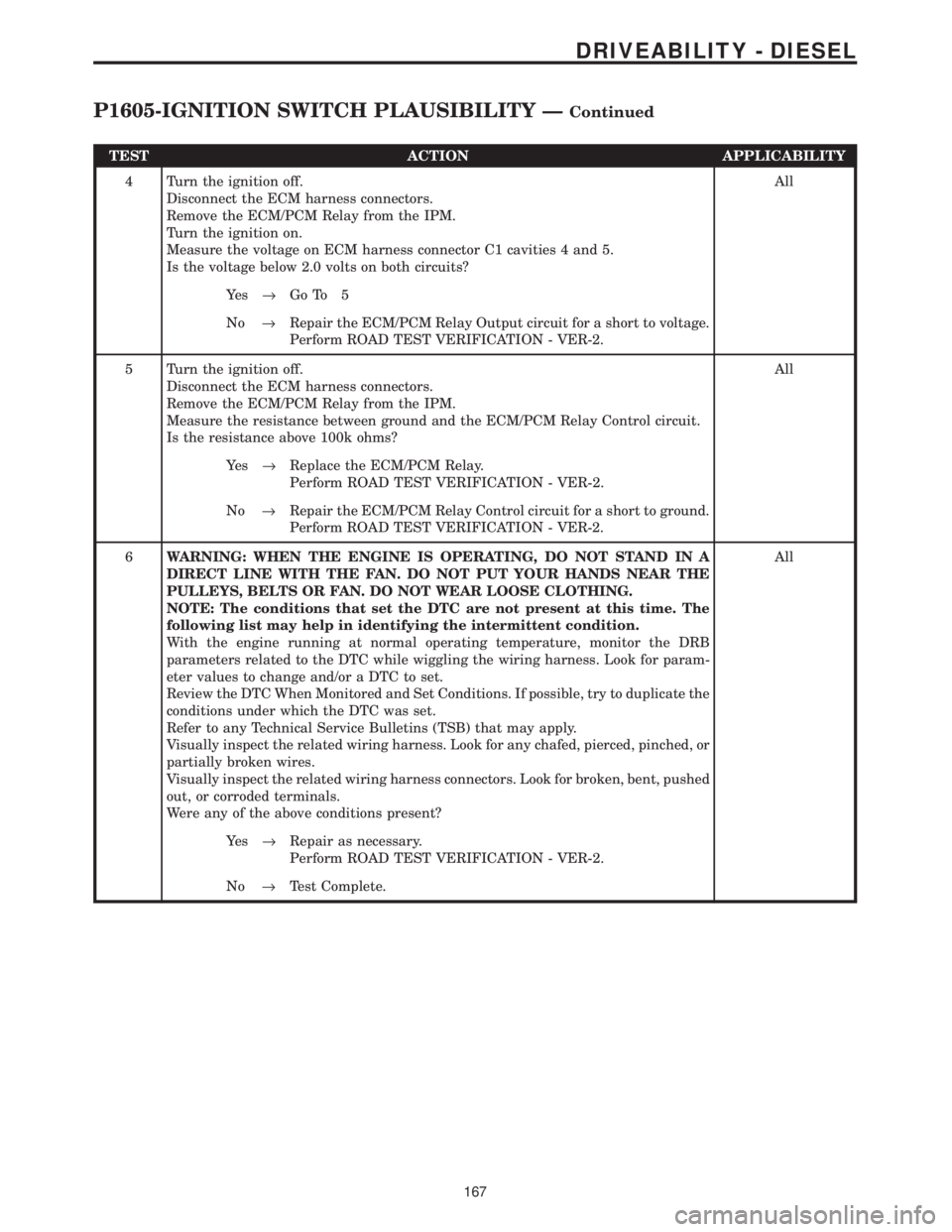
TEST ACTION APPLICABILITY
4 Turn the ignition off.
Disconnect the ECM harness connectors.
Remove the ECM/PCM Relay from the IPM.
Turn the ignition on.
Measure the voltage on ECM harness connector C1 cavities 4 and 5.
Is the voltage below 2.0 volts on both circuits?All
Ye s®Go To 5
No®Repair the ECM/PCM Relay Output circuit for a short to voltage.
Perform ROAD TEST VERIFICATION - VER-2.
5 Turn the ignition off.
Disconnect the ECM harness connectors.
Remove the ECM/PCM Relay from the IPM.
Measure the resistance between ground and the ECM/PCM Relay Control circuit.
Is the resistance above 100k ohms?All
Ye s®Replace the ECM/PCM Relay.
Perform ROAD TEST VERIFICATION - VER-2.
No®Repair the ECM/PCM Relay Control circuit for a short to ground.
Perform ROAD TEST VERIFICATION - VER-2.
6WARNING: WHEN THE ENGINE IS OPERATING, DO NOT STAND IN A
DIRECT LINE WITH THE FAN. DO NOT PUT YOUR HANDS NEAR THE
PULLEYS, BELTS OR FAN. DO NOT WEAR LOOSE CLOTHING.
NOTE: The conditions that set the DTC are not present at this time. The
following list may help in identifying the intermittent condition.
With the engine running at normal operating temperature, monitor the DRB
parameters related to the DTC while wiggling the wiring harness. Look for param-
eter values to change and/or a DTC to set.
Review the DTC When Monitored and Set Conditions. If possible, try to duplicate the
conditions under which the DTC was set.
Refer to any Technical Service Bulletins (TSB) that may apply.
Visually inspect the related wiring harness. Look for any chafed, pierced, pinched, or
partially broken wires.
Visually inspect the related wiring harness connectors. Look for broken, bent, pushed
out, or corroded terminals.
Were any of the above conditions present?All
Ye s®Repair as necessary.
Perform ROAD TEST VERIFICATION - VER-2.
No®Test Complete.
167
DRIVEABILITY - DIESEL
P1605-IGNITION SWITCH PLAUSIBILITY ÐContinued
Page 1392 of 4284
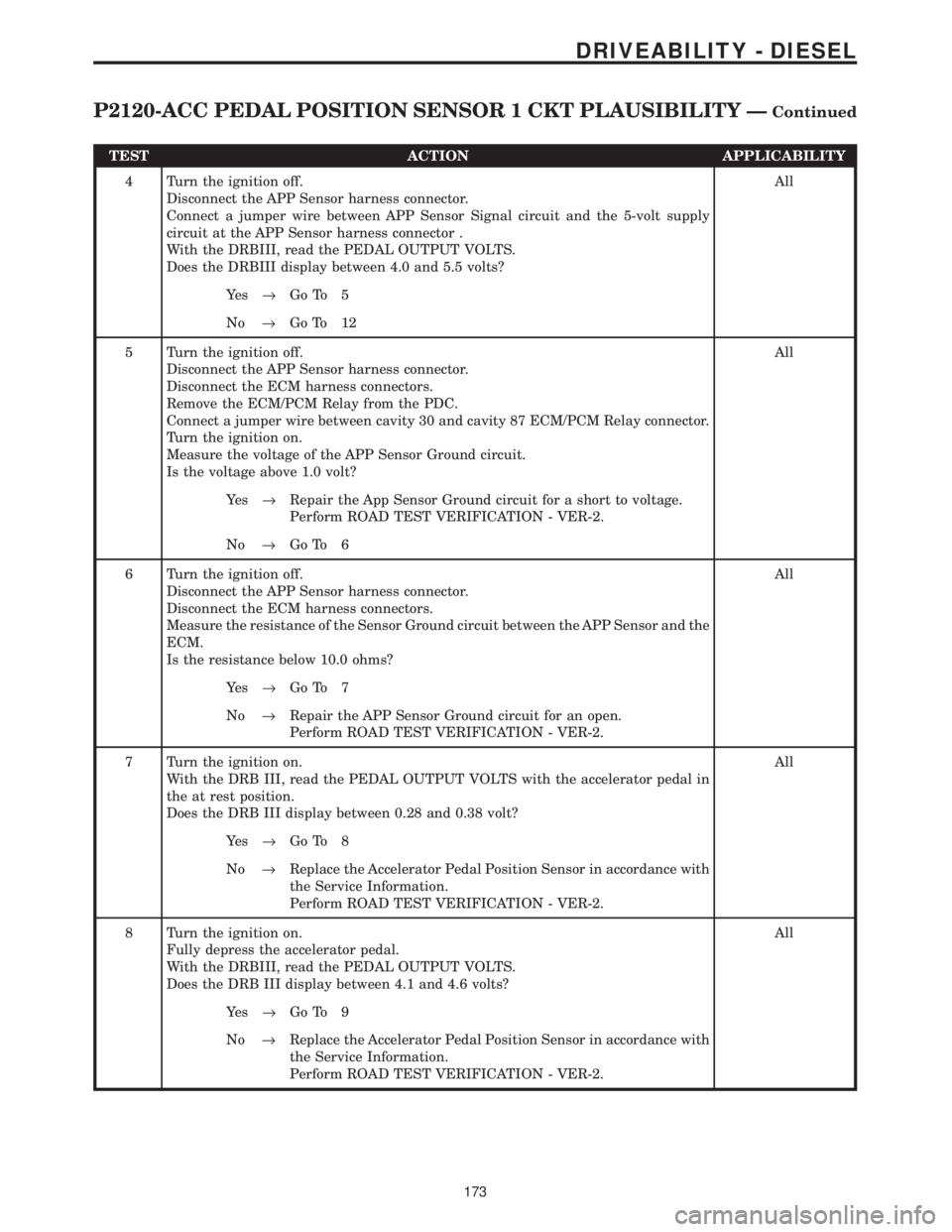
TEST ACTION APPLICABILITY
4 Turn the ignition off.
Disconnect the APP Sensor harness connector.
Connect a jumper wire between APP Sensor Signal circuit and the 5-volt supply
circuit at the APP Sensor harness connector .
With the DRBIII, read the PEDAL OUTPUT VOLTS.
Does the DRBIII display between 4.0 and 5.5 volts?All
Ye s®Go To 5
No®Go To 12
5 Turn the ignition off.
Disconnect the APP Sensor harness connector.
Disconnect the ECM harness connectors.
Remove the ECM/PCM Relay from the PDC.
Connect a jumper wire between cavity 30 and cavity 87 ECM/PCM Relay connector.
Turn the ignition on.
Measure the voltage of the APP Sensor Ground circuit.
Is the voltage above 1.0 volt?All
Ye s®Repair the App Sensor Ground circuit for a short to voltage.
Perform ROAD TEST VERIFICATION - VER-2.
No®Go To 6
6 Turn the ignition off.
Disconnect the APP Sensor harness connector.
Disconnect the ECM harness connectors.
Measure the resistance of the Sensor Ground circuit between the APP Sensor and the
ECM.
Is the resistance below 10.0 ohms?All
Ye s®Go To 7
No®Repair the APP Sensor Ground circuit for an open.
Perform ROAD TEST VERIFICATION - VER-2.
7 Turn the ignition on.
With the DRB III, read the PEDAL OUTPUT VOLTS with the accelerator pedal in
the at rest position.
Does the DRB III display between 0.28 and 0.38 volt?All
Ye s®Go To 8
No®Replace the Accelerator Pedal Position Sensor in accordance with
the Service Information.
Perform ROAD TEST VERIFICATION - VER-2.
8 Turn the ignition on.
Fully depress the accelerator pedal.
With the DRBIII, read the PEDAL OUTPUT VOLTS.
Does the DRB III display between 4.1 and 4.6 volts?All
Ye s®Go To 9
No®Replace the Accelerator Pedal Position Sensor in accordance with
the Service Information.
Perform ROAD TEST VERIFICATION - VER-2.
173
DRIVEABILITY - DIESEL
P2120-ACC PEDAL POSITION SENSOR 1 CKT PLAUSIBILITY ÐContinued